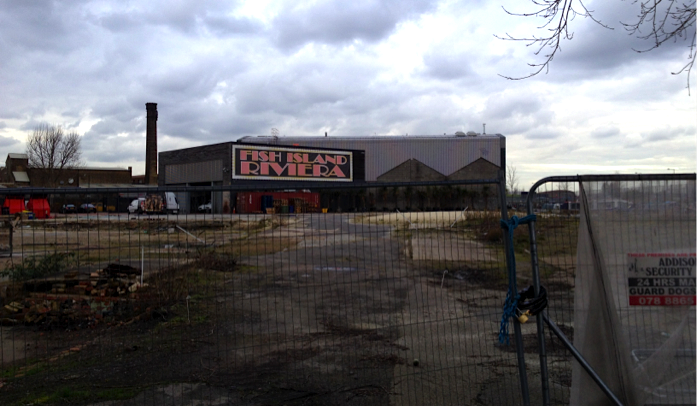
Part one of this blog post is here
The ViewTube sits on the Northern Outfall Sewer, designed by Joseph Bazalgette in the 1850s to channel the waste of a rapidly expanding London population away from the River Thames in order to prevent disease and foul smell, a task it still performs today. The southern part of the sewer forms a 4.5 mile public walkway called the Greenway, which stretches from Bow to the sewage works at Beckton. A popular traffic-free foot and cycle route, but in close proximity to the perimeter fence and the Stadium, the Greenway was closed during the construction of the Olympic Park, and is still only partially open. In the 1990s the IRA attempted to sabotage the Northern Outfall Sewer at Old Ford Lock, but the attack was ineffective. A large amount of terrorist suspects arrested in the capital today are from East London. To the West are the distinctive water towers of the former Bryant & May match factory, scene of the 1888 match girls’ strike, an early example of both feminist and unionist disputes. Now converted into luxury flats, Bow Quarter, as it is now known, was also used by the military during the Games. One resident who objected to his home being used as a missile base was later evicted.
As we walk along the Greenway the AOD measurements of the descending sewer below our feet are marked on concrete blocks beside the path. We are walking upstream. The water treatment plant at Old Ford services the entire Park. There are also tunnels which run from the sewer system underneath the perimeter fence. The Greenway ends at Hackney Wick and the start of Fish Island, a cluster of former factory buildings which has, since the 1980s, been the home of a community of artists and musicians. Many of the factories are now used as studios. We drop down into Dace Road, past the old Percy Dalton Peanut Factory, and up to Old Ford Lock, home to the 1990s TV programme The Big Breakfast. The iconic house is still here but now privately owned. The original Big Brother house was less than a mile away downriver at Three Mills. Next to the Big Breakfast house is the E20 East End Fishing Trust, with friendly staff but dreadful toilets. Many of London’s canals are fished by local residents.
We now walk north along the Lee Navigation towpath which hugs the perimeter fence for a mile or so. The canal is busy with houseboats and swans ducking for rubbish. The waterways were closed during the games, and houseboat registrations closely monitored. There were rumours of a duck-eating crocodile. Forman’s salmon smokery, studios and restaurant are painted an appropriate shade of pink. The business had been forced to relocate having originally been situated within the perimeter fence. On the opposite side of the Park, a community of travellers had also been forced to leave what had, until the successful Olympic bid, been unwanted land. Flanking the water to the West are the remains of a now deserted Olympic after-party. Fortunes were made by the owners of land, which ten years ago had been worth pennies. At White Post Lane, a large collective of anti-establishment artists and activists forms part of the western gateway to the Park. Fish Island and Hackney Wick were the focus of several anti-Olympics campaigns.
Now we can see The Copper Box Arena, formerly the Handball arena. The building is now used as a multi function sports hall and gym, but is frequently closed to the public when it hosts international basketball events. RUN! The northern part of the Park is newly landscaped and has been open to the public since last year. The parkland has hosted several festivals and concerts since the Games, and stretches north up to New Spitalfields Market, a wholesale fruit and veg market which services most of East London, and the Hackney Marshes, famous for its hundreds of amateur football pitches, many of which were concreted over to provide car parks for Olympic traffic.
Amongst the eco systems and reed beds nestle several red phone boxes. Once ubiquitous in Britain and her colonies, the red phone box is now rarely seen outside the tourist areas of Central London. Inside the shopping centre, next to Waitrose, the Great Eastern Market offers shoppers a multi-ethnic culinary experience. We are now back at the start of our journey. John Lewis beckons…
—
As it happened, this narrative describes only the planning of the route. In the week between planning and execution, the shapes and layers of London had shifted once again and we were forced to re-route and reverse. I can only hope that such dynamic improvisation served to underline the organic fluidity of this continually fascinating piece of land.